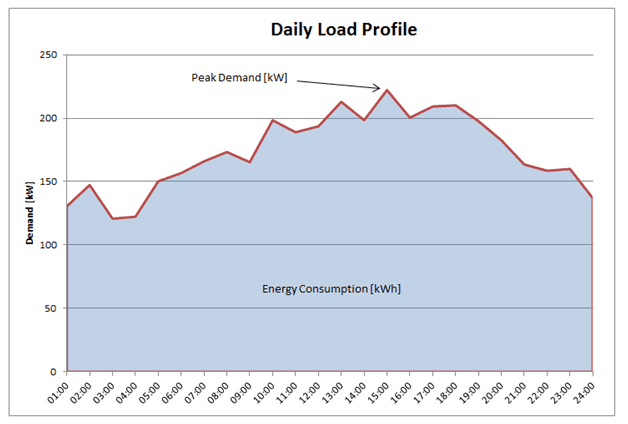What are Demand Charges?
Demand charges are additional fees that utilities charge non-residential or commercial customers for maintaining constant supply of electricity. These fees usually amount to a substantial sum of money that businesses must pay on monthly electric bills. They can be as much as 50% of the total electric bill or more. In some instances, demand charges can actually be higher than the energy portion of the electric bill itself. So the price that a business is charged each month for electricity depends not only on how much electricity was used during the month, but also on the rate at which consumption of electricity occurred. Demand can be defined as:
The maximum amount of energy a business uses at any given point in a billing cycle.
To illustrate this point (see the graph below), let’s assume that we have two five gallon buckets. We fill each bucket full of water. Bucket number one was filled at one gallon per minute while bucket number two at five gallons per minute. Even though we used the same exact amount of water to fill each bucket, the time it took to fill bucket number one was five times that of bucket number two. So, in essence, demand for bucket number two was also five times higher than the demand for bucket number one. This is an analogy for how demand and demand charges work in electricity consumption. Think of it as gallons per minute per unit of time. Or kilowatt hours (kW-hrs) per unit of time.
Electricity consumption is measured in kW-hrs. The electric company monitors your power consumption at fixed time intervals every 15 minutes. Every time a measurement is made for how much electricity is being consumed and at what rate, it’s in kWs. Therefore, the Demand is measured in kWs as well. The electric company charges its commercial customers a specific amount of money for each kW of Demand which occurred in that month. Demand in a given month is the highest point of consumption for that month. So, for example, if a utility charges $24 per kW demand charge and the demand for the month was 100 kW, there will be a demand charge of $2,400 that will appear on the electric bill for that month.
As you can see, the calculation of demand charges is complicated. Not to mention, there are different types of demand charges with different rates as well. These are:
- On peak demand,
- semi-peak demand, and
- off-peak demand
If it wasn’t confusing enough, there is also a “non-coincidental” demand charge that is defined as the highest demand for the month, regardless of when it occurred.
In order to lower demand charges, a business entity must be able to “manage” their demand for electricity. This can be done by identifying the periods when highest demand occurs and trying to “soften” the load by shifting demand for electricity to other times of the day. Solar electric power generation is an effective method for achieving this goal. Demand for electric consumption can be “shifted” to daytime when solar power is being generated which lowers usage of electricity from the grid, thereby reducing demand charges.
This is obviously a very involved and important topic of discussion which we will attempt to expand upon in our future blog posts here at Cosmic Solar.
In the next blog, we’ll examine how solar can be effective in reducing demand charges. We will also attempt to analyze a real world example and highlight some difficulties and challenges of reducing demand charges using real world solar energy solutions that we offer at Cosmic Solar.



